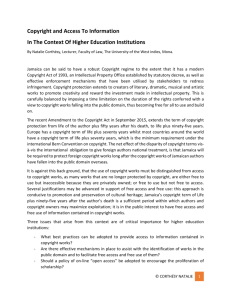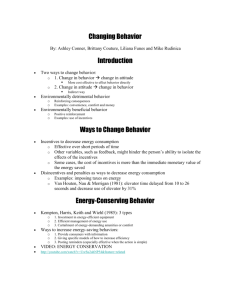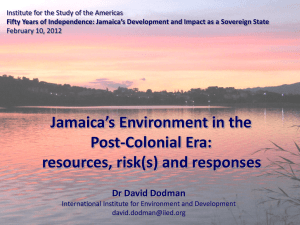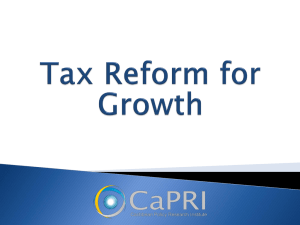Economic instruments for EMS - National Environment & Planning
advertisement
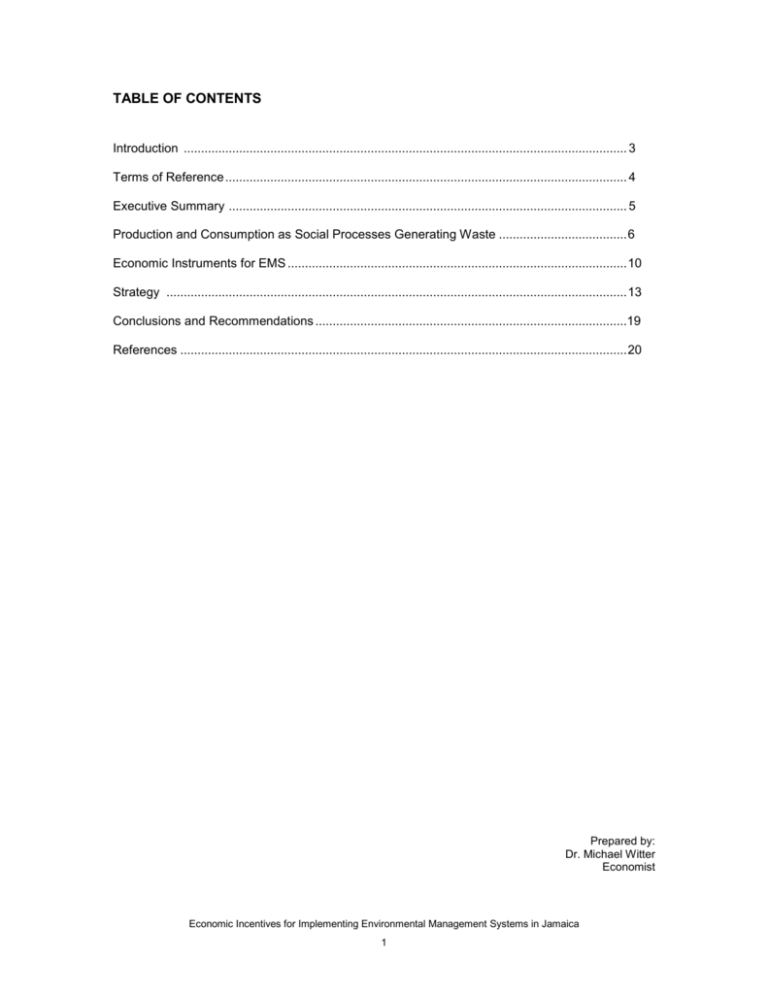
TABLE OF CONTENTS Introduction ................................................................................................................................ 3 Terms of Reference .................................................................................................................... 4 Executive Summary ................................................................................................................... 5 Production and Consumption as Social Processes Generating Waste ..................................... 6 Economic Instruments for EMS .................................................................................................. 10 Strategy ..................................................................................................................................... 13 Conclusions and Recommendations ..........................................................................................19 References ................................................................................................................................. 20 Prepared by: Dr. Michael Witter Economist Economic Incentives for Implementing Environmental Management Systems in Jamaica 1 Economic Incentives for Implementing Environmental Management Systems in Jamaica 2 INTRODUCTION The Jamaican economy at the dawn of the twenty-first (21st) century is a very open extensively liberalized marketplace in which Jamaican enterprises are being outcompeted by imported goods and services and by foreign owned businesses established here. Historically, the incentive system, essentially, the structure of prices, favoured environmentally unfriendly activity. Subsidized chemicals for farming, no user charges for the environment and public recreation facilities, poor waste management systems and practices and low fines for unenforced regulations all contributed to a disregard for the impact of production and consumption on the environment. This study seeks to find ways of changing the incentive system to encourage more environmentally responsible behaviour by firms and households. It begins with a review of the dominant characteristics of the production and consumption processes that impact on the environment, then examines the economic tendencies that run counter to the goal of adopting Environmental Management Systems (EMS), and finally outlines a strategy to change the incentive system gradually. It concludes with some summary remarks and recommendations. Economic Incentives for Implementing Environmental Management Systems in Jamaica 3 TERMS OF REFERENCE The tasks set for the consultant were: 1. Liaise with the EMS policy and strategy Working group (WG) as a whole and specifically the Research Sub Committee of the WG to obtain guidance and information to direct the research effort. 2. Work closely with, and support the efforts of the international consultant Dr. Ira Feldman in conducting the research 3. Identify and collate the existing economic incentives and disincentives to effectively manage the impact of production and consumption on the environment. 4. Do a preliminary assessment of the relative effectiveness of these incentives/disincentives. 5. Use the assessment to guide the formulation of a strategic approach to implementing an EMS throughout the public and private sectors and the community level, and the formulation of policies through which the strategy can be expressed. 6. Generate a list of contact and resource documents for the WG as well as copies of secondary data. 7. Attend and participate in WG retreat scheduled for January 26-26, 2000. 8. Make a presentation on the research findings at the National Policy Forum planned for February 24, 2000. 9. Prepare and submit research paper. Economic Incentives for Implementing Environmental Management Systems in Jamaica 4 EXECUTIVE SUMMARY Economic profitability has historically been based on low values assigned to the natural environment and its resources and low incomes for the working people. As such, the economic system reproduces itself from year to year at the expense of the environment. The challenge for environmental policy is to shift relative prices in favour of the natural environment while minimizing the negative impact on the profitability and hence viability of producers and on the welfare of households. The government has articulated a strategy for improving the quality of the environment in the JANEAP in which it proposed to adopt the polluter pays and the user pays principles as economic instruments to reduce the abuse of the environment and to ensure the efficient utilization of natural and other national resources. Environmental Management Systems will enhance the ability of private enterprises, public institutions, and households to respond positively to the thrust of the government’s environmental policy. The economic strategy to implement EMS is based on providing disincentives to generate waste and to dispose of it improperly and incentives to establish more environmentally friendly activities. It proposes that the central the central government adopt EMS in the public sector through a process of “greening the government” and establish an appropriate set of sanctions for polluters, charges for the use of natural resources and other environmental facilities, and a set of incentives to encourage firms and households toward more environmentally responsible behaviour and to attract investment into environmentally friendly activities. A properly equipped local government working with local businesses and local communities will manage and monitor the use of the natural resources and environmental facilities. Private enterprise is to be encouraged to be pro-active in seeking and seizing opportunities to reduce the negative impact of their operations on the environment and to shift toward more environmentally friendly technologies. In this respect, leadership should be encouraged from the bauxite/alumina companies and the financial sector. Households are to be discouraged from generating excessive waste and disposing of it improperly by appropriate charges for garbage disposal and the use of natural resources and other environmental facilities. The economic strategy requires a consistent, targeted education programme on the benefits of EMS in material terms to the individual institution, and the cost of environmental abuse to the society. It requires as well a legal strategy to base the incentives and disincentives in legislation. Economic Incentives for Implementing Environmental Management Systems in Jamaica 5 PRODUCTION AND CONSUMPTION AS SOCIAL PROCESSES GENERATING WASTE Till today, economic profitability in Jamaica has been based either on the cheapness of labour, the cheapness of the natural environment and its resources, or both. Sugar was launched with slave labour on land seized by the colonizers. Today, its workforce is paid, but wages are low. Bauxite is found in red clay. For years Jamaica got one shilling (worth 14 US cents in those days, or about US$1.15 today) per ton of bauxite. Today, the Levy works out to be approximately US$6 per ton. In terms of gold, it takes 47.5 tons of bauxite to earn from the Levy the equivalent of one (1) ounce of gold. Establishment and individual providers of services to tourists pay nothing for the natural environment, with the exception, in some instances, of the land on which the facilities are sited and a small beach license fee. Apart from sugar, manufacturing in Jamaica today is essentially garment assembly in the two Free Zones, and was attracted to Jamaica by the supply of cheap labour. The sector has been declining since 1995, as other countries in the region are able to offer the manufacturers more productive labour and/or lower relative costs. Most commercial and household users of water pay nothing for it – the National Water Commission collects about 30% of the revenue due to it. Water is a vital input in all production, consumption, and waste disposal processes. All these exemplify the historical trend of assigning low values to human and natural resources. Not only have the resources of the natural environment been assigned low values, but the waste from the processing and consumption these resources is simply dumped back into the natural environment, viewed as a sinkhole with unlimited capacity for the absorption of all forms of waste. Coffee pulp from the factories, dunder from the distilleries and other waste from sugar manufacturing dumped in rivers, caustic soda from the processing of bauxite deposited in red mud lakes, waste from the hotels pumped into the sea, and household waste flowing to the sea through the rivers and gullies, all attest daily to the subconscious assumption that the environment has a limitless capacity to absorb solid waste and waste water. With rising levels of population, of consumption, and hence, waste, and with the non-biodegradable composition of waste increasing, the cost to the environment can no longer be ignored. The challenge for environmental policy is to increase the value of the environment in production and consumption without dislocating the productive sector of the economy and/or imposing undue burdens on an already economically hard-pressed population. With a price structure that increases the value of the environment and its natural resources relative to other goods and services, public and private sector institutions and households will have incentives to reduce waste by improving the efficiency of resource use. Economic Stagnation The Jamaican economy has been stagnating for the past decade. Between 1990 and 1998, the average annual rate of growth of GDP was 0.2%, with per capita GDP declining by about 2%. While the reported unemployment rate has been hovering around 16% throughout the 1990’s, it is well known that underemployment and non-productive self-employment are high. Add to that, the high annual rates of emigration – 22,000 per year, or 91% of the increase in the population between 1990 and 1997 -, and it is clear that the estimated rate of unemployment probably understates the inability of the economy to provide gainful and productive employment for the labour force. Economic Incentives for Implementing Environmental Management Systems in Jamaica 6 Since 1980, the governments have committed the country to a path of private sector export led growth. A gradual process of liberalization began with the World Bank’s structural adjustment loans of the 1980’s, which in turn complemented the series of IMF stabilization programmes initiated in the late 1970’s. In 1991, the pace of liberalization was accelerated with the total liberalization of the foreign exchange market, and the reduction of duties on imported goods. Sugar which benefited from structural adjustment loans from the World Bank has had mixed fortunes well below what was expected by the Bank and the government. Between 1990 and 1998, output increased by 14%, but earnings grew by only 11% on account of weak price movements. Three years after divestment of 70% of the industry to a local business group, the government was forced to reacquire it in the face of imminent bankruptcy. The banana industry is yet to recover from the damage by Hurricane Gilbert in 1988. Production in 1998 was 1% above the level of 1990, but earnings were 12% less. Coffee exports boomed for several years, but went into sharp decline at the end of the 1990’s. Output increased 2.5 times between 1990 and 1997, while earnings increased 1.6 times. In the drive for increased productivity in order to compete internationally, the agricultural export sector has become more chemical intensive. It is estimated that about a third of the pollution of the Kingston Harbour is waste brought in by the Rio Cobre [See SENTAR, 1993]. Much of this is waste from agri-processing and the chemicals in the run-off from the farms that flow into the river. It is also well documented that the rapid expansion of coffee in the 1980’s led to the denuding of large areas of forest in the hills of St. Andrew and Portland, and that the highly toxic chemicals used by the industry run off into the rivers and eventually into the sea accounting for periodic fish kills1. Tourism has shown the most rapid growth and development of any industry in the last two decades. Since 1980, visitor arrivals have increased 3.5 times, and earnings have grown more than four fold (4.2). The construction of many hotels and their beach/shoreline works have disturbed the natural currents in the sea and led to erosion of the beaches. The waste from hotels and other tourist facilities, including cruise ships, has been causing the deterioration of the quality of the beaches, the reefs and the water. Again with facilities outgrowing weak and limited infrastructure for waste disposal and weak regulations, the strong demand for Jamaica’s tourism has eventually begun to undercut itself as the tourists are now expressing preference for healthy environments. It is international demand that polluted the beaches, and it is international demand that will clean them up. Bauxite production has been close to full capacity, somewhat less so in the 1990’s than in the 1980’s, and particularly so in 1999 as a result of the explosion of one of Kaiser’s smelting plants that is supplied by Jamaican bauxite. Between 1990 and 1998, output grew by 15.8%, and earnings per ton of bauxite rose from US$25.55 to US$26.30. Maritime activity has also been growing with the expansion of the transshipment services in Kingston. Between 1990 and 1998, 47% more vessels arrived in Jamaica bringing 29% more cargo. The Port of Kingston has rapidly expanded its transshipment facilities in a bid to capture some of the shipping through the Panama Canal. Domestic agriculture has grown at an annual average rate of 5.4% between 1990 and 1997, with its share of the GDP rising from 3.7% in 1990 to 4.9% in 1997. This is quite remarkable in light of the adverse weather conditions, the high cost of credit, and the competition from imports. As the decade passed, the dynamism of the sector waned, with growth rates declining and 1 It needs to be noted that sometimes pesticides are used illegally to stun fish. Economic Incentives for Implementing Environmental Management Systems in Jamaica 7 ultimately becoming negative in 1997 and 1998, primarily as a result of severe competition from imports in major sub-sectors – livestock, poultry, fruits and vegetables. Manufacturing, with the exception of Free Zone assembly for export, has literally stagnated in the face of competition from imports and the disincentive to investment on account of high interest rates. Beginning in 1996, even the garment sub-sector in the Free Zones began to decline as companies found the cost structures of other countries in the region more attractive. Perhaps the only beneficiary in Jamaica from the collapse of the manufacturing sector in the wake of liberalization is the environment of Kingston. The closing of factories also ended their emissions in the air, and the waste from their operations that often ended up in the sea. The explosion of motor vehicle traffic, and the growth in consumer garbage from households and restaurants, however, probably offset the decline of industrial pollution. Between 1989/90 and 1996/97, there was a 71% increase in registered motorized vehicles of all kind in Jamaica, with no significant increase in the number and size of the roads. Despite the economic stagnation, there has been rapid growth of consumption ultimately financed by foreign and domestic borrowing, remittances from migrants, and informal economic activity. Throughout the 1990’s the distribution of income among social classes appears to have remained constant. In 1998, the highest quintile in the distribution of households by consumption expenditure accounted for 45.33% of total consumption, while the lowest quintile (the poorest) accounted for 6.64%. Similarly, the top two quintiles of households accounted for about 67.06% of total consumption expenditures, while the bottom two accounted for 17.67%. The volumes of waste generated by these households are probably in the same proportions as their consumption expenditures. While due caution has to be exercised in comparing the estimates of the incidence of poverty over the decade of the 1990’s, it appears that the incidence has been falling from a high of upwards of 30% in the mid-1990’s to about 20% at the end of the decade. This is still quite high, and if those households with incomes just above the poverty line are included, the number of vulnerable and potentially vulnerable households is very high. One dimension of poverty is the proliferation of squatting, often on fragile lands (banks of gullies and rivers, steep hillsides), and often without proper solid waste and sewage disposal facilities. Another dimension is the denuding of hillsides, and especially watersheds, through the production of charcoal. Two decades of devaluations, and a decade and a half of liberalization have not been sufficient to make Jamaican businesses internationally competitive. Foreign investors have been slow in acquiring failing companies, even at the bargain prices following each wave of devaluation. In the context of secular stagnation, additional costs associated with reducing the negative impacts on the environment will serve as further disincentives to investors. Ways have to be found to substitute these costs for others, and to lengthen the horizon of investors to include the payback from investments in environmentally friendly technologies and practices. Irrational and Rapid Urban Growth The modern KMA has resulted from irrational urban sprawl north from Kingston through Constant Spring up the Liguanea Plains into the hills of St. Andrew and west across the Kingston Harbour into the plains of St. Catherine [See, Davies, 1975]. One dimension of the irrationality is the inadequacy of the systems to dispose of solid waste and sewage generated by a rapidly growing urban population. It has been estimated that the households in the KMA account for about a third of the pollution of the Kingston harbour [See SENTAR, 1993]. Nationally, households generated about 60% of the solid waste, excluding red mud from the bauxite sector [See, Jamaica’s Solid Waste Management Policy, 2000]. It has also been well established that the septic tanks of the Economic Incentives for Implementing Environmental Management Systems in Jamaica 8 houses on the Liguanea Plains have increased the nitrogen levels of the groundwater to the point where several wells have been declared unfit for human consumption. The government’s estimate is that about 10% of Jamaica’s ground water has been contaminated by pollution from septic tanks [Ministry of Water, 1999]. Consumption Patterns Popular consumption patterns have been changing rapidly as a result of the molding of values by USA television advertisements and the easy access of imports to the Jamaican market. In Kingston 39.9% of food expenditure is on “meals away from home”; for Jamaica as a whole, the comparable figure was 31.3%. In 1990, “meal’s away from home” accounted for 22% of food consumption [See SLC, 1998]. The rapid growth is probably a good indicator of the proliferation of foreign fast food chains. With the increased consumption of processed and prepared foods has come the increase in packaging and other waste material. Whereas the fruit skin and seed, the empty coconut, the leftovers from cooked meals are absorbed by the environment, the plastic bottles and Styrofoam packaging are non-biodegradable. Government Unwillingness to Intervene in the Economy Since 1980, all governments have committed themselves to private sector led economic growth. In pursuit of a liberal economy, the government in the 1990’s has tried to reduce its intervention in the economy, but has unwillingly had to rescue the financial sector, the major agricultural exports, the national airline, some hotels, and to scramble to establish regulatory mechanisms for liberalized sectors, after the fact. Especially in the context of the persistent stagnation of the economy, the government is keen on easing, rather than increasing, the public burden (fines, taxes) on businesses. Non-Analytic Management Culture The culture of management in Jamaica has been forged in a protected environment in which information and the analysis of the information was not significant. Even today, a decade and a half into liberalization, many senior managers and executives eschew analysis and are suspicious of modern technology and information systems. Whereas historically, management systems have been hierarchical, modern technologies require highly trained, computer literate workers operating in teams with sufficient autonomy to facilitate their creativity and initiative. Taken together, the historical patterns of resource use and misuse, the stagnation of the economy in the face of intensifying global competition, changing consumption patterns and a backward culture of management present formidable obstacles to the adoption of EMS in the private sector and the management of waste in the household. The fundamental challenge is to internalize the “externalities”, as the economists put it, by paying the full cost for the use of the natural environment and the resources contained therein. Economic Incentives for Implementing Environmental Management Systems in Jamaica 9 ECONOMIC INSTRUMENTS FOR EMS Market There are powerful market forces pushing enterprises in Jamaica toward adopting a more responsible role in the promotion of the health of the environment. Most important, are the international market forces for a cleaner environment that are expressing themselves in the bauxite/alumina, tourism, and export agriculture industries. These industries are the main earners of foreign exchange, and as such, they influence business practice in the economy as a whole. Bauxite/Alumina The multinational corporations that operate the Jamaican bauxite/alumina industry have already begun implementing EMS in line with the international commitments of their Head Offices to ISO 14001 or some comparable set of standards. In 1992, ALCAN’s board of directors formally “incorporated environmental management into the Company’s highest level of decision-making”. [ALCAN, 1998] Plants, such as those in Jamaica, are required to have specific plans to deal with their impact on the local environment, and the implementation of this plan is “directly linked to the personal performance objectives of managers and employees”. Similarly, ALCOA and Kaiser have committed themselves to achieving ISO 14001 certification on their worldwide operations. In the face of the energy crisis of the 1970’s, these companies were forced to become more energy efficient in the energy intensive smelting process. Today, more than 60% of aluminum is recovered from recycled waste. While there is no smelting in Jamaica, the commitment of these corporations to recycling in their manufacturing operations exemplifies their commitment to maintaining proper environmental standards, even as it reduces the relative demand of Jamaican ore. Tourism The demand for a healthy environment by tourists is driving the industry to higher and higher environmental standards. The EAST project audited 15 hotels for “energy use, water use, wastewater generation, solid waste generation, use of chemicals and management and staff practices.” [See R.Wynter and M.Orane, 4/2/2000]. The audits conducted by the project successfully identified savings in each hotel. It also found that there was a relatively low level of awareness of environmental issues among the management and that most managers were unwilling to invest in the solutions that would make them realize the potential savings from an EMS. Nevertheless, five (5) hotels received the Green Globe certification with others expressing interest. There are other examples of eco-tourism facilities and services initiating changes to reduce the negative impacts of their activities on the environment. These vary from attractions such as YS Falls with its no litter policy and strict limits on the number of visitors admitted at any one time to communities launching community eco-tourism initiatives such as Bluefields. Export Agriculture In addition to its historical problems – bad weather, poor industrial relations, management and technical inefficiencies – the sugar industry is facing a threat to its market access similar to the threat to the market in the EU for bananas. Little headway has been made in bringing production costs down from about twice the price competitors are charging. Economic Incentives for Implementing Environmental Management Systems in Jamaica 10 For some time now, pressure has been building on the industry to address the improper disposal of wastewater. The Sugar Research Institute (SIRI) has prepared an eight (8) year “Action Plan for Environmental Management and Monitoring at Sugar Factories”. The Plan identifies seven (7) steps ending with the commissioning and operation of wastewater treatment systems. While the Plan is behind its implementation schedule, it is at least a clear indication of where the industry thinks it has to go to address the negative impacts of wastewater discharge from the factories. The sugar industry has recent success with the reuse of waste materials. In the crunch of the energy crisis, the decision was made to use bagasse as an energy source to displace oil imports, and this has been implemented successfully. The banana industry in Jamaica is facing the loss of its markets with the imminent removal of its preferential access to the EU market. One potential adjustment is to target a high-income niche with environmentally friendly bananas. In Costa Rica, environmentalists have developed a “Smart banana” programme to certify products that are produced under environmentally friendly conditions. This indicates that there is a movement in the banana industry in favour of new methods of production under environmental management systems. International pressure is building on the coffee industry for an environmentally friendly product. “In 1996, the industry hosted the first Sustainable Coffee Congress --- to raise awareness of coffee’s role in the ecology of the tropics, and to define the criteria and marketing framework for socially conscious, environmentally friendly coffee.” [See Wynter and Orane, 2000] In addition to the various international conventions signed by the government of Jamaica, many international loans and development aid packages now require certain measures to clean up and to protect the environment. With Jamaica’s dependence on foreign loans, the environmental conditions in these agreements will pressure the government to become more pro-active in formulating and implementing environmental policy. A recent loan to the sugar industry in Jamaica by the CDB carried stipulations on the environmental impact of the industry. National Market Forces Deposit-Refund: By far the deposit-refund system operated by Desnoes and Geddes (D&G) for the recycling of beer and soft drink bottles is the best example of a market incentive pushing companies and household towards environmentally responsible behaviour. To be sure, the scheme was initiated because it was more economical to re-use bottles than to manufacture new ones. Hence, both consumers in need of fast cash and D&G had an incentive to make the scheme viable. A survey in 1994 [Carroll, P., et al, 1994] cited D&G’s estimate that 50% of the Red Stripe (by far the most popular beer then) bottles were recovered. Other companies (e.g., West Indies Glass) have also engaged in deposit-refund schemes from time to time. Since 1994, much has changed as D&G has switched to plastic bottles that are not re-used by the company. Reuse and Recycling – Informal reuse and recycling of waste materials is common in Jamaica. Many shacks in poor communities are constructed from a variety of materials clearly visible to the casual observer. Glass and plastic bottles are collected, washed and reused for domestic as well as commercial purposes. For example, quart bottles used for rum and fruit syrup re-appear on the honey market, and plastic bottles are used in the retail trade for kerosene and bulk detergent. It was found that the widespread recycling of lead in backyard smelters was responsible for high incidences of lead poisoning in certain communities. Economic Incentives for Implementing Environmental Management Systems in Jamaica 11 In 1994, West Indies Pulp and Paper discontinued the recycling of paper as a result of damage to its facilities by fire. The company eventually abandoned recycling as the scale of activity made it unprofitable in the era of a liberal import regime. Wysinco’s Pet recycling project collected about 12% of PET bottles through partnerships with schools, churches and other groups in 1999. [See Call Associates, 1999/2000] Export – There have been periodic exports of plastic bottles by Wysinco Environmental Limited to China, and regular exports of waste paper from West Indies Pulp and Paper. Waste export to foreign recycling facilities is perhaps one of the more viable options for the disposal of waste by a small economy like Jamaica. At the end of March 2000, it was announced that the four major manufacturers and distributors of soft drinks have agreed to fund an organization to recycle PET bottles. They will receive financial support from other major trading companies to collect, crush and export PET bottles. Synthesis The international market pressures for protecting the environment are stronger than the pressures that come from national market forces, and should be assigned the lead role in the strategy for getting the business sector to implement EMS. But, there are important local private sector interests committed to “a program for solid waste management, litter reduction and Pet recycling in Jamaica”, and there are opportunities in the Jamaican marketplace for profitable investment, but for technical, or other kinds of difficulties. Both the pressures from outside of Jamaica and those from inside the market must be harnessed in the strategy to promote EMS. These forces for change will encounter a resistance born of the historical pattern of resource use in production and consumption. The strategy to promote EMS must seek to tip the balance in favour of the forces pushing the economy toward more environmentally friendly activities. Economic Incentives for Implementing Environmental Management Systems in Jamaica 12 STRATEGY The national strategy to get public and private institutions to adopt EMS should be gradual, with a focus on the on the major polluters of the KMA, the hotels in the resort areas, and the disposal of red mud. The economic strategy must be linked directly to the educational and legal aspects of the strategy. The economic strategy must be three-pronged. First, it must seek to undermine markets for environmentally unfriendly products while boosting markets for environmentally friendly products. Second, it must seek to shift the structure of prices in favour of the natural environment. Third, it must seek to increase the share of investment funds going into environmentally friendly technologies and activities. Below, we outline the respective roles of the social partners. Government Like other countries, the government of Jamaica will have to play a lead role in promoting EMS. There is already an official environmental policy articulated in the Jamaica National Environmental Action Plan (JANEAP), in which the government has already made firm and farreaching commitments to improve the quality of the environment. “The Government recognizes that guiding the economy towards sustainable development will require the use of appropriate economic tools and incentives. These instruments are needed to encourage environmentally responsible decision-making by investors, consumers, and other economic actors This approach is based on the “polluters pay” and “users pay” principles, and is meant to encourage better and more efficient management of natural resources, and to recover the full costs of pollution control, discourage use of environmentally damaging products, and encourage recycling and reuse of materials.” [JANEAP, 1994, P.6] JANEAP committed the Government to: 1. Applying the polluters pay principle to increase sewage fees, “introduce household refuse disposal fees and tipping fees”, special fees for the proper disposal and fines for the improper disposal of hazardous waste; 2. Tax incentives to encourage recycling and the use of environmentally friendly technologies 3. Promote deposit refund schemes to encourage the collection of litter and other recyclable waste 4. Special taxes for environmentally damaging products, such as fertilizers, pesticides, ozone depleting substances, batteries, fuels and hazardous substances such as dry cleaning fluids 5. Applying the users pay principle to natural resources in a similar fashion to royalties mandated under the Mining Act (1947). Targeted areas include fees for the extraction of underground water, for harvesting forest and fisheries resources, for visits by tourists to natural attractions, and for public use of national parks and protected areas. It will, however, be necessary for the government to formulate and articulate a clear policy statement on the importance of EMS to implementing its environmental policy, and to the economic development and the health of the island. This policy statement will have to be backed by credible action in the form of the adoption of a green policy for government operations, fines and other forms of sanctions for polluters, incentives for retrofitting productive plant with environmentally friendly technology, the establishment of environmental grading for establishments, and the implementation of projects targeted at assisting major polluters to clean up their activities. Economic Incentives for Implementing Environmental Management Systems in Jamaica 13 1. Greening government operations: In Canada, greening government operations meant: a. “Procurement of goods and services that meet environmental standards for federal [government] use b. Energy efficiency and water conservation in Federal [government] buildings and facilities; c. Solid waste reduction; d. Reuse and recycling associated with Federal [government] operations; e. Effective management of the Federal [government] fleet of vehicles to reduce emissions and hazardous waste; f. Consideration of sustainable development principles in Federal [government] land-use planning and management and in all other aspects of Federal [government] operations, including training of federal [government] personnel.” [See Costs and Benefits –1996] A similar posture by the government of Jamaica would be far-reaching considering the relative size of the central government in the economy. Most of export agriculture, some tourist attractions and facilities, both water and electricity, the major hospitals, most of the primary and secondary schools are under government control and would therefore be subject to the greening of operations. There are potential pitfalls that must be anticipated. For example, a green procurement policy would probably benefit importers, as many Jamaican producers will take time for their products to qualify by meeting some prescribed set of environmental standards. Many local producers rely on government procurement for an important part of their sales. It is perhaps useful to add to the list used by the government of Canada the stipulation that every public institution should implement an EMS. Environmental policy lends itself naturally to decentralized governance. While the central government will have the responsibility for setting national policy, the Parish Councils ought to vested with the responsibilities for managing resource use and waste disposal, and for monitoring pollution in their jurisdictions. Equally, their experience with policy implementation at the local level will enable the Parish Councils to contribute to the formation of policy by central government. The proximity of the Parish Councils to the problems and to the communities that benefit from and/or are affected by them, is their principal advantage, but these institutions would have to be given the capabilities to undertake these tasks. They should then be required to strive towards earning sufficient revenues from these activities by some agreed deadline, to put them on a self-sustaining basis. By extension, it is through the Parish Councils that the national policy has the most chance of being embraced at the level of the communities. The communities represent an important source of information about the use of resources and the generation of waste and pollution. Further, the pressure of an informed and organized community can be an effective check against environmental abuse as numerous protests against corrosive emissions from the processing of bauxite, against smoke pollution from burning dumps, and against sewage and waste disposal in rivers, have shown. Economic Incentives for Implementing Environmental Management Systems in Jamaica 14 2. Incentives for retrofitting with environmentally friendly plant and equipment: Several business leaders who were interviewed for this study indicated that they would be willing to accept a lower rate of profit on environmentally friendly projects than on their traditional commercial activities, if they could access incentives from the government. The two types of incentives most frequently mentioned were duty relief on imported equipment and subsidized interest rates. As cited in 1. above, the government has committed itself to granting incentives for investment in environmentally friendly technologies, by way of exception to the general thrust of public policy not to interfere with the market. Firms already benefiting from one of the existing incentive schemes can import equipment for environmentally friendly technologies on a concessional basis. Extending incentives for importing clean technologies to firms not benefiting from any incentive scheme would increase the amount of revenue foregone by the government. On the other hand, duties on capital goods are quite low, ranging from 0% to 10%. This foregone revenue must be compared with the avoided costs of cleaning up the waste and pollution from environmentally unfriendly technologies. The National Industrial Policy, in seeking to address the weaknesses of the existing incentive schemes, committed the government to “reorient fiscal incentives in the direction of making them: More transparent, simple, and automatic; Based on quantifiable and easily monitored performance standards; More flexible so that a broader cross-section of firms can benefit from the provisions; and Oriented equally to services, agriculture, and manufacturing activity.” [NIP, 1996, P. 58] It is not clear how far the reform of the incentive system has gone, but the process of change represents an opportunity to insert provisions for the adoption and implementation of clean technologies. Notice that the NIP’s reform of the existing incentives addresses sectoral concerns – services, agriculture, and manufacturing. Yet, the challenge of implementing EMS and conducting healthy environmental practices cuts across all sectors. However, in the section on Environmental Policy, the NIP addresses the issue of incentives for enhancing the environmental practices of firms. “A system of environmental standards, regulations, and effective mechanisms for monitoring enforcement will be established and maintained. This system will be complemented by incentives to support environmentally friendly practices, processes, technologies, and products.” [NIP, 1996, P.105] While the bulk of the incentives are fiscal, there are other forms worth considering and evaluating. First, in a high interest rate regime, reduced interest rates are attractive to investors. A pool of funds at reduced interest rates earmarked for investment in viable environmental projects would be a meaningful incentive. Second, assistance with reducing bureaucratic transactions costs, with training programmes, with technical assistance and with marketing are also services that can be included in an incentive package. Third, while moral incentives are of decreasing importance in Jamaican society, they still have some value in “topping up” incentive packages. Some examples of these are public recognition through awards for the enterprise and its staff, and certificates of excellence and/or achievement that can be referenced in projecting the enterprise’s image into the marketplace. A condition for accessing incentives should be the implementation of a functioning EMS by the management. A firm with a functioning EMS is more likely to utilize incentives productively. Economic Incentives for Implementing Environmental Management Systems in Jamaica 15 3. Fines and other sanctions for pollution: Sanctions must be sufficiently severe to serve as deterrents to polluters, and in some cases, they can and should be used for productive purposes. Fines must be sufficiently high to serve as a deterrent but sufficiently low as to be affordable. In addition, sanctions must be enforceable, and fines must be collectible. Enterprises could be required to participate in cleaning up the environment as a sanction for excessive pollution. The quantities and qualities of emissions are not easy to measure and to monitor, and the charges for violation of regulations are difficult to set, and are not easy to assess. Much more work needs to be done on the specific emissions and discharges of the major polluters. One sanction for an institution that pollutes is to require the management to implement an EMS. Ultimately, this will redound to the benefit of the institution and reduce the probability of violations of pollution standards. 4. Target major commercial polluters for pilot projects: Major polluters have been identified. The government should seek to formulate a project jointly with each major polluter to reduce the negative emissions and discharges, rather than try to tackle all polluters at once. A policy that appears to be vindictive toward the polluter will generate resentment and ill-will, especially if the enforcement mechanism appears to be unequal in its targeting and treatment of different polluters. A gradual approach beginning with cooperation with the polluter to reduce the pollution, with sanctions as a last resort, is recommended. Eventually when the public is properly educated, a more vigilant approach may become feasible. Ultimately, the goal is to get the public consciousness to accept that the polluter must pay the cost of cleaning up. All major polluters should be required to implement an EMS. 5. Grading of establishments for environmental friendliness: A good example of a grading system for environmental friendliness has been developed in Indonesia, the so-called Proper system [See Shakeb Afsah and Dmayanti Ratynanda, 199??]. Essentially, enterprises that meet certain standards are given a seal for public display. The certification is a good marketing tool for the enterprise, and enhances its competitiveness. In Jamaica, a set of standards established and administered by a council of environmental NGO’s would be one way of institutionalizing the NGO’s in the strategy to implement EMS while at the same time distancing the grading system from political interference. 6. Encourage the bauxite/alumina companies to implement the environmental safeguards and to maintain the standards to which they are committed, and to share their experiences with the local businesses. The single largest form of waste and the most toxic waste in Jamaica is the red mud waste of the bauxite industry. Every effort must be made to reduce the impact of this industry on the environment. If the companies implement their own environmental safeguards and adhere to the high standards to which they are committed, the negative impacts on the environment will be reduced. The companies must be urged to comply with their own standards and to be transparent in monitoring their compliance with their own standards. Further, the companies must see sharing their experiences of implementing EMS with local businesses as an integral part of responsible corporate citizenship. 7. Encourage the hotels to seek Green Globe or other comparable certification. Green Globe certification requires efficiency in energy and water use, management of fresh water, waste reduction, wastewater management, environmentally sensitive purchasing policy, and the promotion of social and cultural development. Perhaps the Jamaica Hotel and Tourist Association can be charged with recommending the organizations whose certifications are in Economic Incentives for Implementing Environmental Management Systems in Jamaica 16 the best long-term market interests of the Jamaican industry. The Ministry of Tourism should consider requiring a commitment to implement an EMS and to achieve acceptable standards of environmental practices as a condition for granting licenses to operate tourist facilities. 8. Education on the efficiencies that can be derived from EMS. Government sponsored education programmes on the advantages of EMS should be organized on a continuous basis, especially for the top management of the private sector and major public enterprises. There are many examples of environmental management resulting in cost savings, if only because an audit of resource use invariably reveals areas of waste. This is contrary to the widespread impression in the business community that environmentally friendly techniques and technologies are necessarily more expensive. This is another important area in which NGO’s are already playing a leading role. Government should encourage and support these efforts in coordination with its legal and economic strategies. 9. Environmental charges on resources: These will be unpopular and will have to be carefully and gradually implemented. But charging for the use of basic resources, such as energy and water, will be the only method for reducing waste by eliminating excessive consumption. There is already an “energy charge” built into electricity bills. 10. Special consideration for recycling projects: There are limited possibilities for profitable recycling in Jamaica because of the relatively small scale of waste compared to the requirements of modern recycling technology. Nevertheless, government should actively consider requests for support of limited duration for potentially viable recycling processes. Just as our exports of raw materials have defined our role in international processing, so too export of waste can be our role in an international recycling system. Similarly, there is a lot of scope for reuse of materials in the informal economy. This is a potential avenue for government intervention to support socially desirable informal economic activities, such as the provision of shelter, the packaging of goods produced in household or cottage industries (e.g., newspaper, binding materials, wooden pallets, bottles), the collection of motor oils and so on. Households 11. Target upper middle class neighbourhoods for separation of garbage. Some middle class neighbourhoods should be targeted for pilot projects to encourage the separation of household waste. This could lead into a project to reduce waste since it is the upper classes who account for a disproportionately high share of national consumption, and who therefore generate a disproportionately high share of household waste. These households are quite familiar with such practices in other countries, particularly in North America. 12. Charges for Waste disposal: The draft national Solid Waste Policy proposes a system of waste collection and disposal based on the polluter pays principle and operated by private contractors licensed by a legislated authority. Trucking contractors will collect haulage fees from commercial and institutional entities for collection of their waste. Similarly, trucking contractors will collect haulage fees from the National Solid Waste Management Authority for household and street side garbage. They in turn will be required to pay tipping fees for disposal of collected waste at official dumpsites operated by other contractors. Instituting charges for waste collection and disposal will increase the risk of garbage being diverted from the dump into the gullies and other informal dumpsites. The draft Solid Waste Policy mentions penalties violators in passing, and proposes no new enforcement agency. Rather, it seeks to empower the Municipal wardens being established by the Local Economic Incentives for Implementing Environmental Management Systems in Jamaica 17 Authorities, as well as environmental wardens, Public Health Inspectors, Resort patrol and Traffic wardens, and to mount a programme of public and community education. While the policy is clear and well conceived, like other environmental policies, it must be implemented consistently for it to be effective. 13. Target suburban areas for composting of household organic waste. The reduction of household waste will only be achieved when the household has to bear more costs for the disposal of the waste. A compost heap offers the household one way of reducing disposal costs while providing benefits to small-scale agricultural activities. Deposit refund schemes and recycling collection centres provide monetary incentives to the household for proper disposal of waste. Private Sector 14. The Industry Coalition for Litter Reduction, working under the auspices of the Jamaica Manufacturers’ Association (JMA) and modeled after a similar body in Puerto Rico [See Call, 1999/2000], has been established and should be broadened as soon as possible. International industrialists have been holding conferences and pledging commitments to safeguarding the environment since 1984 [See WICEM II]. The Jamaican private sector must be encouraged to emulate this trend within the progressive international business community. The leadership of the private sector should be enlisted in the leadership of the campaign to implement EMS in private enterprises. 15. The leadership of the financial sector should be charged with designing instruments and schemes to increase the flow of investment funds into environmentally friendly products. The government also has an interest in the conversion of short-term debt accumulated in its fight against inflation into long-term instruments. Environmental bonds with both government guarantee and foreign and national private sector participation and management are one possible source of an investment fund for approved projects. Such long-term instruments should be targeted at the private investor community, tat Jamaicans overseas and at public institutions. A condition for drawing down on the fund financed with the bonds should be that the borrower implements an EMS if one is not already in place. Tourists 16. Many countries have used voluntary contributions from tourists to help fund environmental causes. Jamaica has had some experience with similar schemes with little success. A way has to be found to facilitate contributions by tourists whose primary interests are in activities that are dependent on the good quality of the environment. If no voluntary scheme succeeds, a study should be done to determine the environmental charge that the trade will bear. This is yet another application of the user pays principle. Synthesis The economic challenge for the strategy to promote EMS is to increase the cost of resource use and waste disposal without reducing the profitability of the firm. This will be especially difficult in a high interest rate regime in which all but the most lucrative investment projects are deferred in favour of the holding of financial instruments. This will require the search for savings in other areas on account of social inefficiencies, such as high security costs, bureaucratic delays of transactions, high utility costs, and high interest rates. Here is yet another instance of environmental policy having to take account of social and other non-environmental factors. Economic Incentives for Implementing Environmental Management Systems in Jamaica 18 CONCLUSIONS AND RECOMMENDATIONS The government has made firm and far-reaching commitments to improving the quality of the environment both in international fora and in national policy. In particular, it recognizes the need to use market forces to guide the economy towards clean production technologies, waste reduction and proper waste management. It now must concentrate on implementation of its policy commitments as set out in the JANEAP, the NIP, and the draft Solid Waste Policy. In addition it must use the opportunity of the preparation of the Tourism Master Plan to complement and to extend the policy initiatives just mentioned with special reference to the most environmentally sensitive of all the sectors of the economy. A campaign for private enterprises, public institutions, and households to implement environmental management systems (EMS) is a potentially important vehicle for the society to move toward the goals of the government’s environmental policy. Environmentally friendly business opportunities should be identified and encouraged by the appropriate incentives, while making polluters and users pay. In such a context, the management of private enterprises, public institutions and households will have incentives to internalize environmental concerns within their management systems, and disincentives for not instituting EMS. While the central government has to determine the policy framework, the Parish councils should bear the principal responsibilities for implementing public policy, and managing and monitoring the quality of the local environment. The Parish Councils should in turn mobilize communities to assist in the management and monitoring of their environs. Private enterprises that have already implemented EMS should be enlisted in the leadership of the campaign to have EMS adopted by other private enterprises. In summary, all sectors – government, foreign private, national private, voluntary, and household – must play a clearly identified role in the collective implementation of the strategy. The strategy for implementation should be carefully targeted for the maximum benefit to the environment and to public education about the environment. Specifically, the strategy should prioritize the polluters, with the aim of getting the biggest polluters to implement EMS first. In this respect, the Bauxite/Alumina companies have led the way. Similarly, the users of selected resources, in particular water, energy, public parks and attractions should be prioritized with a view to developing an appropriate system of user charges. Since the KMA is such a concentration of commerce and households, and the resort areas are so environmentally sensitive, the implementation programmes should start in these areas and concentrate most of the resources there. To concretize the strategy, it will be necessary to conduct micro studies to determine the appropriate levels and modalities of incentives, the socially acceptable standards of environmental quality, and the fines and charges for specific and relevant forms of pollution and other environmental abuse. Finally, the economic strategy for implementing EMS must be coordinated with the legal and educational strategies. Economic Incentives for Implementing Environmental Management Systems in Jamaica 19 REFERENCES Afsah, Shakeb and Dmayanti Ratynanda, “Environmental Performance Evaluation and Reporting in Developing Countries: The Case of Indonesia’s Programme for Pollution Control, Evaluation and Rating (PROPER), in “Sustainable Measures ---”, 199? ALCAN, 1998 Call Associates, Beyond the Horizon: A Programme for Solid Waste Management and Pet Recycling in Jamaica, 1999/2000 Carroll, P., et al, Greater Montego Bay Solid Waste Management Study, USAID, 1994 Conference Report and Background Papers, Second World Industry Conference on Environmental management, Rotterdam, 1991 (WICEM II) Costs and Benefits of Greening Federal government Operations: Final Report, May 15, 1996 Davies, Omar, Urban Growth and Management: Final Report, 1975 Ditz, Daryl, Janet Rangathan, R. Darryl Banks (eds), Green Ledgers: Case Studies in Corporate Environmental Accounting, World Resources Institute, 1995 Figueroa, M. “Economic Incentives and Non-Biodegradable Waste in the English-speaking Caribbean”, paper presented to Seminar on The Use of Economic Instruments in Environmental Management, organized by the Sustainable Development Council of Jamaica and the NRCA, October 8, 1997 Figueroa, M. “Urban Green Spaces in the Kingston Metropolitan Area: A Case for Action”, prepared for CEPAT course, November 18, 1997 Government of Jamaica, National Industrial Policy: A Strategic Plan for Growth and Development, April 25, 1996. Jamaica’s Solid Waste Management Policy, draft report of the Solid Waste Management Project, UNDP/GOJ, March 2000 McCalla, Winston, “Country Report on Incentives and Barriers for Recycling: Jamaica”, in Incentives and Barriers for Recycling in the Caribbean: Five Country Reports, April 1997 Ministry of Environment and Housing, “Legislative Framework for Sustainable Development in Jamaica”, Draft, April 10, 1998 Ministry of Water, “Water and Sanitation: 2000 and Beyond”, The Observer: Water Policy Supplement, October 3, 1999 NRCA and PIOJ, Jamaica National Environmental Action Plan, 1994 Pereira, Beverley and Michael Witter, “The Management of Kingston Harbour: Institutional Aspects and the Role of the Harbour in the Jamaican Economy”, prepared for NRCA’s project, Planning and Management of Heavily Contaminated Bays and Coastal Waters in the Wider Caribbean: the Case of Kingston Harbour, March 1997 Economic Incentives for Implementing Environmental Management Systems in Jamaica 20 Persaud, Bishnodat, Matthew Wright, and Warren Benfield, “Market Based instruments for Urban Environmental Management”, Draft, 199? Peterson, Jerrold, ‘Use of pricing to encourage recycling: A case study of a small region’s solid waste program”, paper presented to the International Conference on integrating Economic and Environmental Planning for Islands a Small States, Malta, March 14-16, 1996 PIOJ and STATIN, Jamaica Survey of Living Conditions, 1998 SENTAR, Final Phase II Report: Volume 3 of 3 - Appendix XVIII, Environmental Impact Analysis, Kingston Harbour Environmental Project, December 1993 Uno, Kimio, Environmental Options: Accounting for Sustainability, Kluwer Academic Publishers, 1995 PIOJ unpublished draft of a paper on “Economic Instruments” Winter, George, Blueprint for Green management, McGraw-Hill, 1995 World Bank, Greening Industry, Oxford University Press, 2000 Wynter, R., and M.Orane, EMS Policy and Strategy Working Group “Target Sectors” Research Report, 4/2/2000 Economic Incentives for Implementing Environmental Management Systems in Jamaica 21

